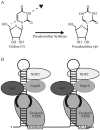Therapeutic suppression of premature termination codons: mechanisms and clinical considerations (review)
- PMID: 24939317
- PMCID: PMC4094583
- DOI: 10.3892/ijmm.2014.1809
Therapeutic suppression of premature termination codons: mechanisms and clinical considerations (review)
Abstract
An estimated one-third of genetic disorders are the result of mutations that generate premature termination codons (PTCs) within protein coding genes. These disorders are phenotypically diverse and consist of diseases that affect both young and old individuals. Various small molecules have been identified that are capable of modulating the efficiency of translation termination, including select antibiotics of the aminoglycoside family and multiple novel synthetic molecules, including PTC124. Several of these agents have proved their effectiveness at promoting nonsense suppression in preclinical animal models, as well as in clinical trials. In addition, it has recently been shown that box H/ACA RNA-guided peudouridylation, when directed to modify PTCs, can also promote nonsense suppression. In this review, we summarize our current understanding of eukaryotic translation termination and discuss various methods for promoting the read-through of disease-causing PTCs, as well as the current obstacles that stand in the way of using the discussed agents broadly in clinical practice.
Figures



References
-
- Brenner S, Barnett L, Katz ER, Crick FH. UGA: a third nonsense triplet in the genetic code. Nature. 1967;213:449–450. - PubMed
-
- Brenner S, Stretton AO, Kaplan S. Genetic code: the ‘nonsense’ triplets for chain termination and their suppression. Nature. 1965;206:994–998. - PubMed
-
- Bonetti B, Fu L, Moon J, Bedwell DM. The efficiency of translation termination is determined by a synergistic interplay between upstream and downstream sequences in Saccharomyces cerevisiae. J Mol Biol. 1995;251:334–345. - PubMed
Publication types
MeSH terms
Substances
Grants and funding
LinkOut - more resources
Full Text Sources
Other Literature Sources

